Heinrich J.G., Aldinger F. (Eds.) Ceramic Materials and Components for Engines
Подождите немного. Документ загружается.

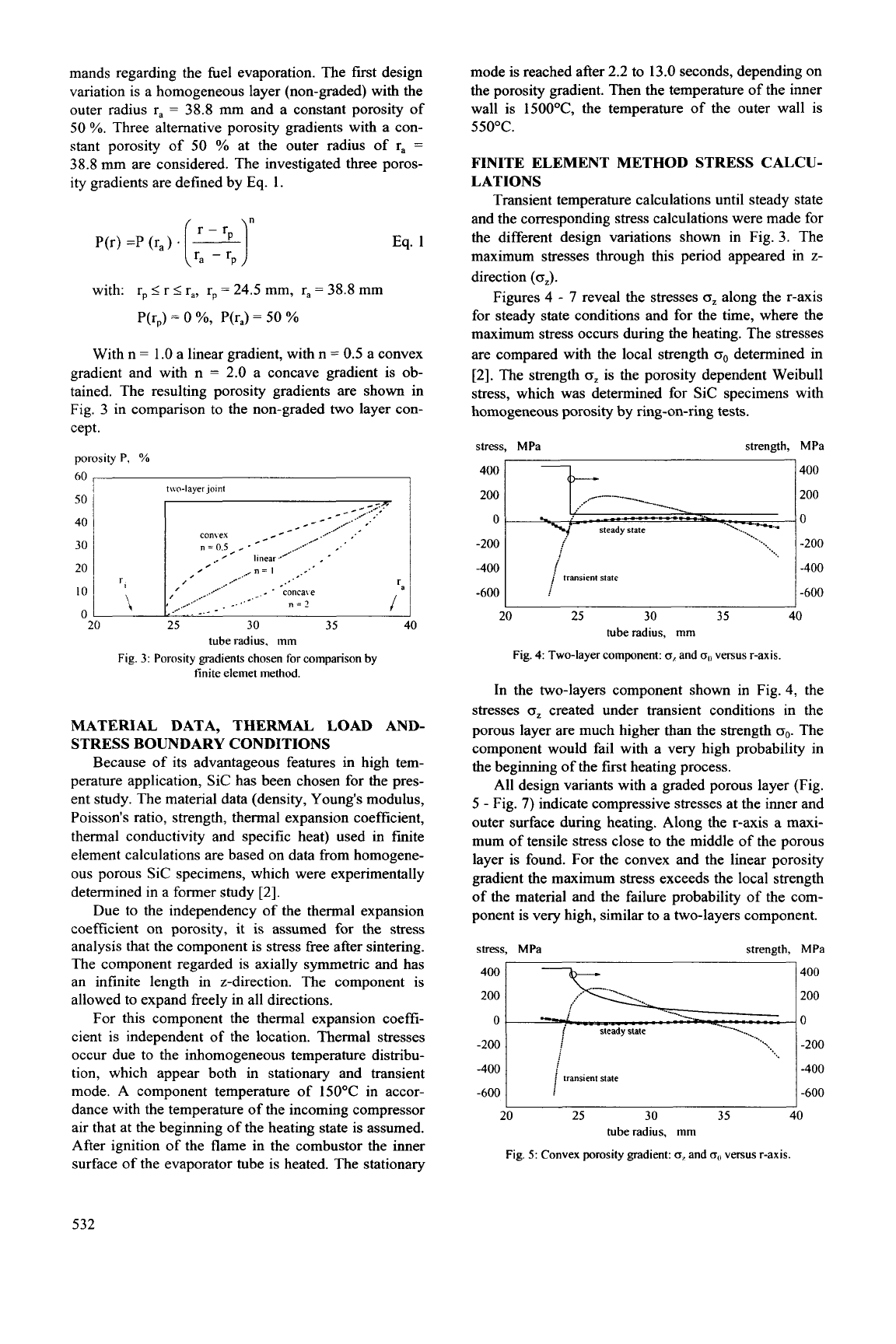
mands regarding the fuel evaporation. The first design
variation is a homogeneous layer (non-graded) with the
outer radius ra
=
38.8
mm and a constant porosity of
50
%.
Three alternative porosity gradients with a con-
stant porosity of
50
%
at the outer radius of r,
=
38.8
mm are considered. The investigated three poros-
ity gradients are defined by
Eq.
1.
Eq.
1
with: rp
5
r
5
ra, rp
=
24.5 mm, r,
=
38.8
mm
P(r,)
=
0
%,
P(r,)
=
50
%
With n
=
1
.O
a linear gradient, with
n
=
0.5
a convex
gradient and with n
=
2.0 a concave gradient is ob-
tained. The resulting porosity gradients are shown in
Fig.
3
in comparison to the non-graded two layer con-
cept.
porosity
P.
%
50
20
0
20
.
.
concaie
I
,./
_.--
.
-.
n=?
,...
,I.'
...'
25 30 35
40
tube radius. inin
Fig.
3:
Porosity gradients chosen for comparison
by
finite elemet method.
MATERIAL DATA, THERMAL LOAD AND-
STRESS BOUNDARY CONDITIONS
Because of its advantageous features in high tem-
perature application, Sic has been chosen for the pres-
ent study. The material data (density, Young's modulus,
Poisson's ratio, strength, thermal expansion coefficient,
thermal conductivity and specific heat) used in finite
element calculations are based
on
data from homogene-
ous porous Sic specimens, which were experimentally
determined in a former study [2].
Due to the independency of the thermal expansion
coefficient on porosity, it is assumed €or
the
stress
analysis that the component is stress free after sintering.
The component regarded is axially symmetric and has
an infinite length in z-direction. The component is
allowed to expand freely in all directions.
For this component the thermal expansion coeffi-
cient is independent of the location. Thermal stresses
occur due to the inhomogeneous temperature distribu-
tion, which appear both in stationary and transient
mode. A component temperature of 150°C in accor-
dance with the temperature of the incoming compressor
air that at the beginning of the heating state is assumed.
After ignition of the flame in the combustor the inner
surface of the evaporator tube is heated. The stationary
mode is reached after 2.2 to
13.0
seconds, depending
on
the porosity gradient. Then the temperature of the inner
wall
is
15OO0C, the temperature
of
the outer wall is
550°C.
FINITE ELEMENT METHOD STRESS CALCU-
LATIONS
Transient temperature calculations until steady state
and the corresponding stress calculations were made for
the different design variations shown in Fig.
3.
The
maximum stresses through this period appeared in
z-
direction
(0,).
Figures
4
-
7
reveal the stresses
(T,
along the r-axis
for steady state conditions and for the time, where the
maximum stress occurs during the heating. The stresses
are compared with the local strength
o0
determined in
[2]. The strength
(T,
is the porosity dependent Weibull
stress, which was determined for Sic specimens with
homogeneous porosity by ring-on-ring tests.
stress, MPa strength, MPa
400
I
3-
I400
"%.,
1-200
-600
-400
20
25
30
35
40
tuberadius,
mm
Fig.
4:
Two-layer component:
6,
and
0,)
versus r-axis.
In the two-layers component shown in Fig. 4, the
stresses
(T,
created under transient conditions in the
porous layer are much higher than the strength
oo.
The
component would fail with a very high probability in
the beginning of the first heating process.
All design variants with a graded porous layer (Fig.
5
-
Fig.
7)
indicate compressive stresses at the inner and
outer surface during heating. Along the r-axis a maxi-
mum of tensile stress close to the middle of the porous
layer is found. For the convex and the linear porosity
gradient the maximum stress exceeds the local strength
of the material and the failure probability of the com-
ponent is very high, similar to a two-layers component.
stress, MPa strength,
400
I
--4---
-400
-600
I
transient
state
20
25 30 35
tube radius,
mm
Fig.
5:
Convex porosity gradient:
o,
and
0,)
versus
r-axis.
M Pa
400
200
0
-200
-400
-600
1
532
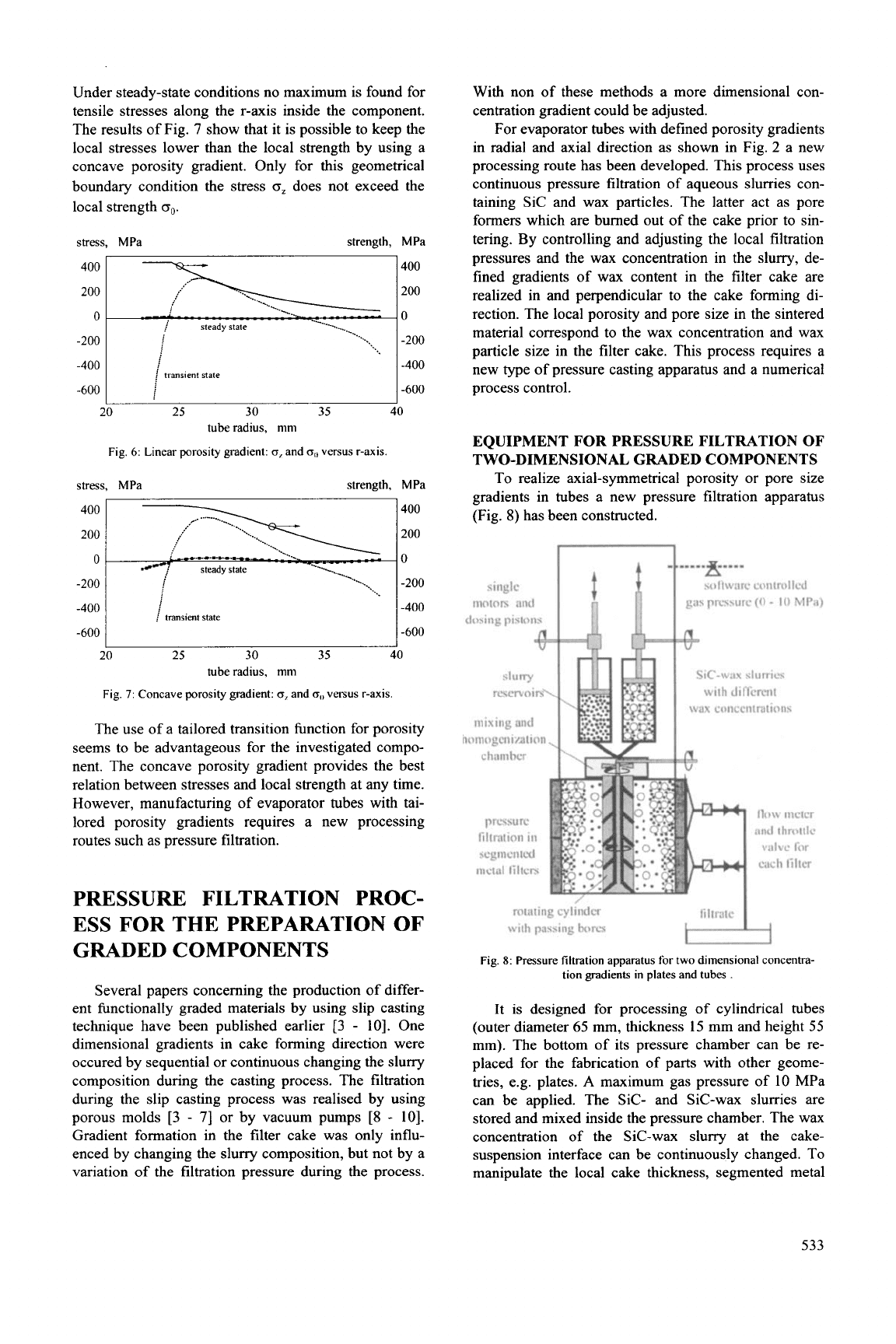
Under steady-state conditions no maximum is found for
tensile stresses along the r-axis inside the component.
The results of Fig.
7
show that it is possible to keep the
local stresses lower than the local strength by using a
concave porosity gradient. Only for this geometrical
boundary condition the stress
0,
does not exceed the
-400
-600
local strength
o,,.
stress, MPa
-400
-600
;
transient
state
strength,
400
I
at--
/....\
-.
-..
*%_
200
0
;
-....__
--_.
/
steady stale
i
-200
-400
i
transient state
-600
I
20 25 30 35 40
tube radius, nini
Fig.
6:
Linear porosity gradient:
0,
and
(T,,
versus r-axis.
MPa
400
200
0
-200
-400
-600
stress, MPa strength, MPa
400
I400
0
-200
The use of a tailored transition fimction for porosity
seems to be advantageous for the investigated compo-
nent. The concave porosity gradient provides the best
relation between stresses and local strength at any time.
However, manufacturing of evaporator tubes with tai-
lored porosity gradients requires a new processing
routes such as pressure filtration.
PRESSURE
FILTRATION
PROC-
ESS
FOR
THE PREPARATION
OF
GRADED
COMPONENTS
Several papers concerning the production of differ-
ent hnctionally graded materials by using slip casting
technique have been published earlier
[3
-
101.
One
dimensional gradients in cake forming direction were
occured by sequential or continuous changing the slurry
composition during the casting process. The filtration
during the slip casting process was realised by using
porous molds
[3
-
71
or by vacuum pumps
[8
-
101.
Gradient formation in the filter cake was only influ-
enced by changing the slurry composition, but not by a
variation of the filtration pressure during the process.
With
non
of these methods a more dimensional con-
centration gradient could be adjusted.
For evaporator tubes with defined porosity gradients
in radial and axial direction as shown in Fig.
2
a new
processing route has been developed. This process uses
continuous pressure filtration of aqueous slurries con-
taining Sic and wax particles. The latter act as pore
formers which are burned out of the cake prior to sin-
tering. By controlling and adjusting the local filtration
pressures and the wax concentration in the slurry, de-
fined gradients of wax content in the filter cake are
realized in and perpendicular to the cake forming di-
rection. The local porosity and pore size in the sintered
material correspond to the wax concentration and wax
particle size in the filter cake. This process requires a
new type of pressure casting apparatus and a numerical
process control.
EQUIPMENT FOR PRESSURE FILTRATION OF
To realize axial-symmetrical porosity or pore size
gradients in tubes a new pressure filtration apparatus
(Fig.
8)
has been constructed.
TWO-DIMENSIONAL GRADED COMPONENTS
software controlled
gas pmsure
(0
-
I0
M
Pa)
pressure
filtration in
segniented
metal
filters
Sic-wax
slurries
with
different
wax conccntrdtions
I
flow nietcr
and throttlc
valve for
etch
tilts
filtrate
I,
rotating cylinder
with passing bores
Fig.
8:
Pressure filtration apparatus for
two
dimensional concentra-
tion gradients in plates and tubes
.
It is designed for processing of cylindrical tubes
(outer diameter
65
mm, thickness
15
mm and height
55
mm). The bottom of its pressure chamber can be re-
placed for the fabrication of parts with other geome-
tries, e.g. plates.
A
maximum gas pressure of
10
MPa
can be applied. The Sic- and Sic-wax slurries are
stored and mixed inside the pressure chamber. The wax
concentration of the Sic-wax slurry at the cake-
suspension interface can be continuously changed. To
manipulate the local cake thickness, segmented metal
533
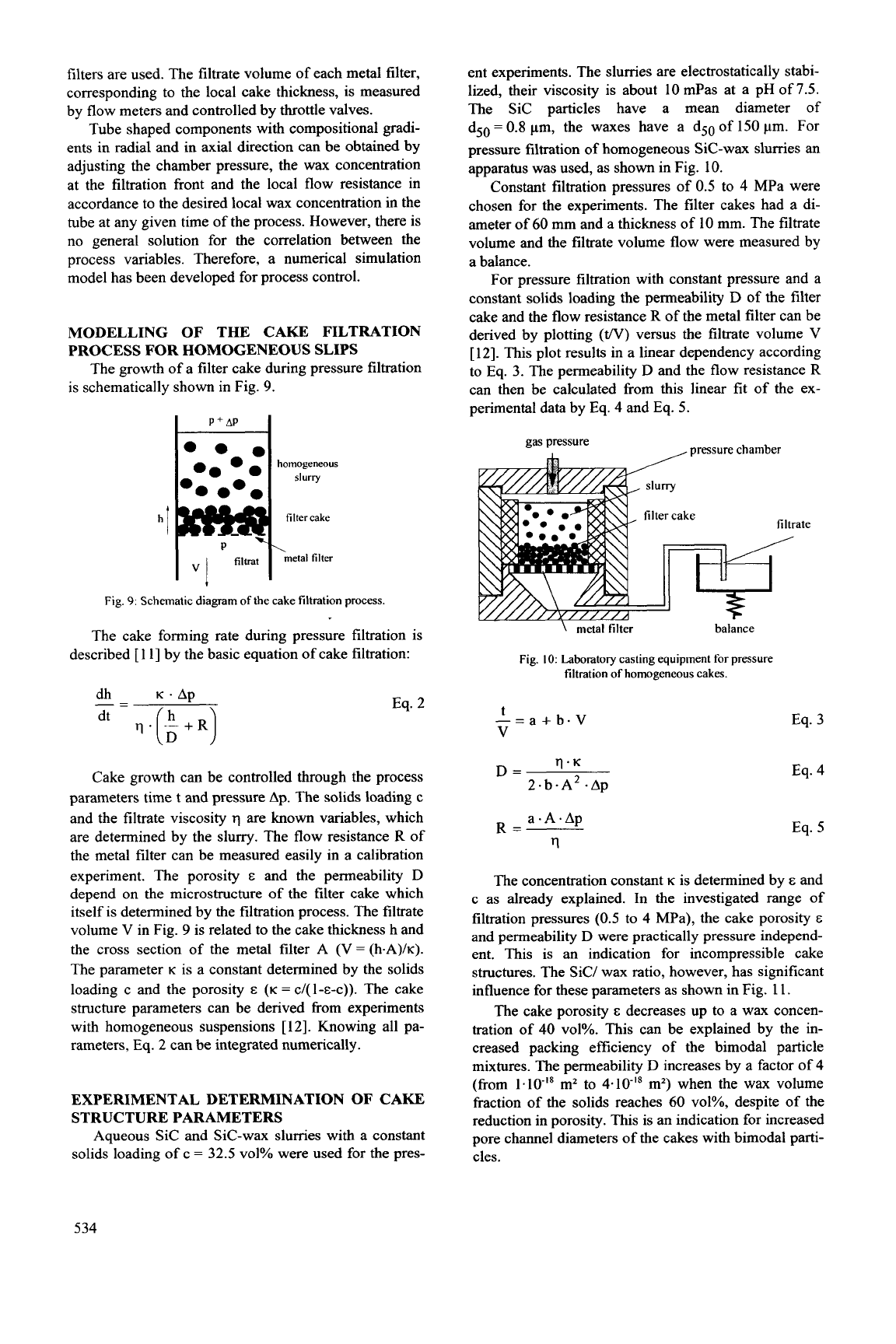
filters are used. The filtrate volume of each metal filter,
corresponding to the local cake thickness, is measured
by flow meters and controlled by throttle valves.
Tube shaped components with compositional gradi-
ents in radial and in axial direction can be obtained by
adjusting the chamber pressure, the wax concentration
at the filtration front and the local flow resistance in
accordance to the desired local wax concentration in the
tube at any given time of the process. However, there is
no
general solution for the correlation between the
process variables. Therefore, a numerical simulation
model has been developed for process control.
MODELLING
OF
THE CAKE FILTRATION
PROCESS FOR HOMOGENEOUS SLIPS
The growth of a filter cake during pressure filtration
is schematically shown in Fig.
9.
h
j
ltercake
filtrat
metal
filter
Fig.
9:
Schematic diagram of the cake filtration process.
ent experiments. The slurries are electrostatically stabi-
lized, their viscosity is about
10
mPas at a pH of 7.5.
The Sic particles have a mean diameter of
d50
=
0.8
pm, the waxes have a d50 of 150 pm.
For
pressure filtration of homogeneous Sic-wax slumes an
apparatus was used,
as
shown in Fig.
10.
Constant filtration pressures of 0.5 to
4
MPa were
chosen for the experiments. The filter cakes had a di-
ameter of
60
mm and a thickness of 10 mm. The filtrate
volume and the filtrate volume flow were measured by
a balance.
For pressure filtration with constant pressure and a
constant solids loading the permeability
D
of the filter
cake and the flow resistance
R
of the metal filter can be
derived by plotting
(t/V)
versus the filtrate volume
V
[
121. This plot results in a linear dependency according
to Eq. 3. The permeability
D
and the flow resistance
R
can then be calculated from this linear
fit
of the ex-
perimental data by Eq.
4
and Eq. 5.
gas
pressure
m
,pressure chamber
\
metal filter balance
The cake forming rate during pressure filtration is
described
[
1
I]
by the basic equation of cake filtration:
Fig.
10:
Laboratory casting equipment
for
pressure
filtration
of
homogeneous cakes.
K
.
Ap
-
dh
-_
dt
q.(k+R)
t
-=a+b.V
V
Eq. 2
Cake growth can be controlled through the process
parameters time t and pressure Ap. The solids loading c
and the filtrate viscosity
q
are known variables, which
are determined by the slurry. The flow resistance
R
of
the metal filter can be measured easily in a calibration
experiment. The porosity
E
and the permeability
D
depend
on
the microstructure
of
the filter cake which
itself is determined by the filtration process. The filtrate
volume
V
in Fig.
9
is related to the cake thickness h and
the cross section
of
the metal filter A (V=(h.A)k).
The parameter
K
is a constant determined by the solids
loading c and the porosity
E
(~=c/(l-~-c)). The cake
structure parameters can be derived from experiments
with homogeneous suspensions
[
121. Knowing all pa-
rameters, Eq.
2
can be integrated numerically.
EXPERIMENTAL DETERMINATION
OF
CAKE
STRUCTURE PARAMETERS
Aqueous Sic and Sic-wax slurries with a constant
solids loading of c
=
32.5 vol% were used for the pres-
q*K
D=
2. b
.
A
.
Ap
a.A.Ap
rl
R=
filtrate
I
Eq. 3
Eq.
4
Eq.
5
The concentration constant
K
is determined by
E
and
c as already explained. In the investigated range of
filtration pressures
(0.5
to
4
MPa), the cake porosity
E
and permeability
D
were practically pressure independ-
ent. This is an indication for incompressible cake
structures. The Sic/ wax ratio, however, has significant
influence for these parameters as shown in Fig.
1
1.
The cake porosity
E
decreases up to a wax concen-
tration of
40
~01%. This can be explained by the in-
creased packing eficiency
of
the bimodal particle
mixtures. The permeability
D
increases by a factor of
4
(from 1.10-'' m2 to
4.10-''
m2) when the wax volume
fraction of the solids reaches
60
vol%, despite of the
reduction in porosity. This is an indication for increased
pore channel diameters of the cakes with bimodal parti-
cles.
534
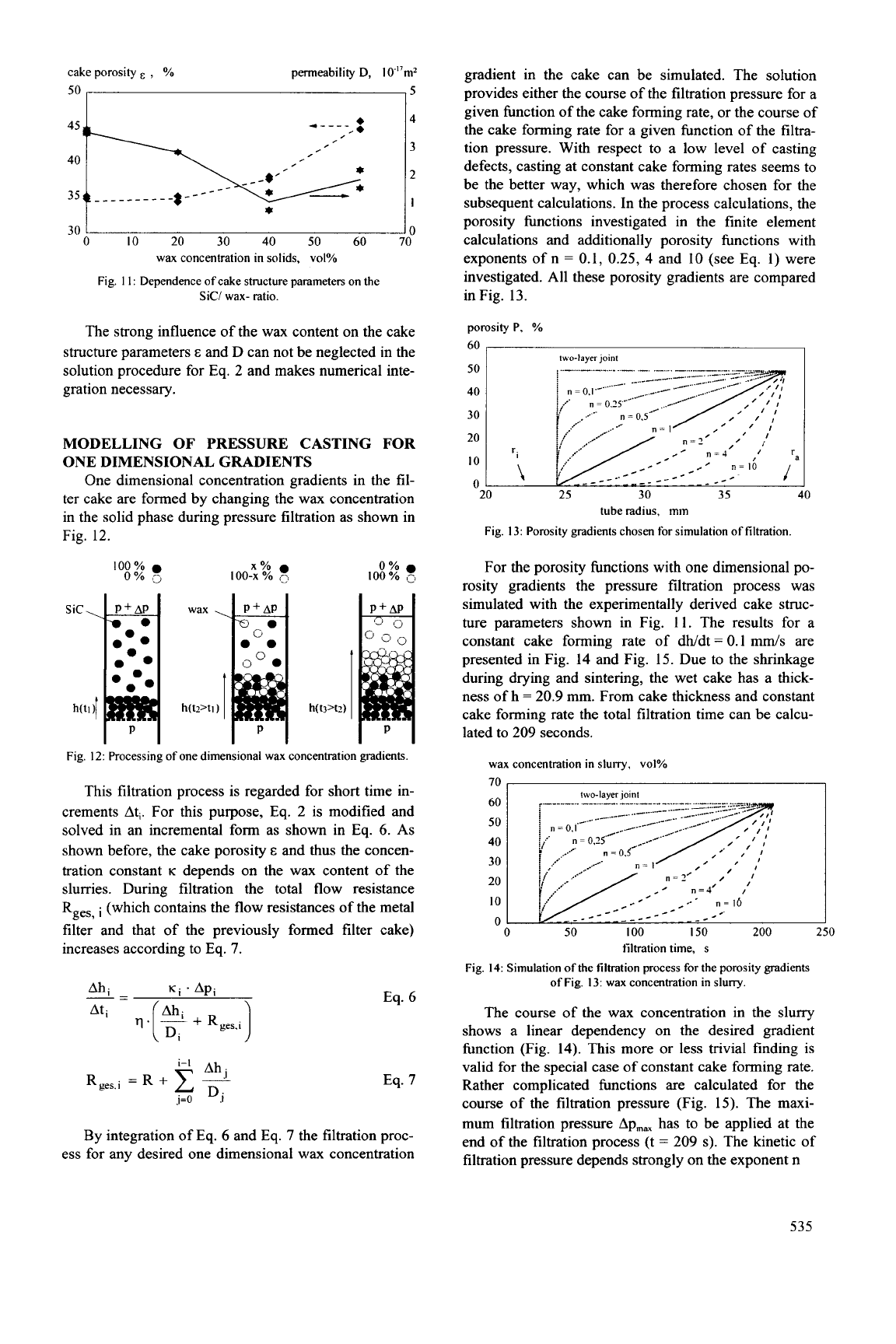
14
:----'
35t
-
--
--
- -
-
--
lo
0
10
20
30
40
50
60
70
wax concentration in solids,
vol%
Fig.
I I
:
Dependence
of
cake structure parameters
on
the
Sic/ wax- ratio.
The strong influence of the wax content on the cake
structure parameters
E
and D can not be neglected in the
solution procedure for Eq. 2 and makes numerical inte-
gration necessary.
MODELLING OF PRESSURE CASTING FOR
ONE DIMENSIONAL GRADIENTS
One dimensional concentration gradients in the fil-
ter cake are formed by changing the wax concentration
in the solid phase during pressure filtration as shown in
Fig. 12.
100%
0%
(3
X%
100-x
%
0%
100
Yo
Fig. 12: Processing
of
one dimensional wax concentration gradients.
This filtration process is regarded for short time in-
crements Ati. For this purpose, Eq. 2 is modified and
solved in an incremental form as shown in Eq.
6.
As
shown before, the cake porosity
E
and thus the concen-
tration constant
K
depends on the wax content of the
slurries. During filtration the total flow resistance
Rges,
i
(which contains the flow resistances of the metal
filter and that of the previously formed filter cake)
increases according to Eq.
7.
Eq.
6
Eq.
7
By integration of Eq.
6
and Eq.
7
the filtration proc-
ess for any desired one dimensional
wax
concentration
gradient in the cake can be simulated. The solution
provides either the course of the filtration pressure for a
given function of the cake forming rate, or the course of
the cake forming rate for a given function of the filtra-
tion pressure. With respect to a low level of casting
defects, casting at constant cake forming rates seems to
be the better way, which was therefore chosen for the
subsequent calculations.
In
the process calculations, the
porosity fimctions investigated in the finite element
calculations and additionally porosity fimctions with
exponents of n
=
0.1, 0.25,
4
and 10 (see Eq. 1) were
investigated. All these porosity gradients are compared
inFig. 13.
porosity
P,
%
60
two-laver ioint
50
40
30
20
10
0
20
25
30
35
40
tube radius, mm
Fig. 13: Porosity gradients chosen
for
simulation
of
filtration.
For the porosity functions with one dimensional po-
rosity gradients the pressure filtration process was
simulated with the experimentally derived cake struc-
ture parameters shown in Fig. 11. The results for a
constant cake forming rate of dh/dt
=
0.1 mm/s are
presented in Fig. 14 and Fig. 15. Due to the shrinkage
during drying and sintering, the wet cake has a thick-
ness of h
=
20.9 mm. From cake thickness and constant
cake forming rate the total filtration time can be calcu-
lated to 209 seconds.
wax concentration in slurry,
vol%
70
two-laver ioint
1
-___-_. __-.
'I'
0
50
I00
I50
200
filtration time,
s
Fig.
14:
Simulation
of
the filtration process
for
the porosity gradients
of
Fig. 13: wax concentration in slurry.
The course of the wax concentration in the slurry
shows a linear dependency
on
the desired gradient
fbnction (Fig. 14). This more or less trivial finding is
valid for the special case of constant cake forming rate.
Rather complicated functions are calculated for the
course of the filtration pressure (Fig.
15).
The maxi-
mum filtration pressure Apma has to be applied at the
end of the filtration process (t
=
209
s).
The kinetic of
filtration pressure depends strongly on the exponent
n
250
535
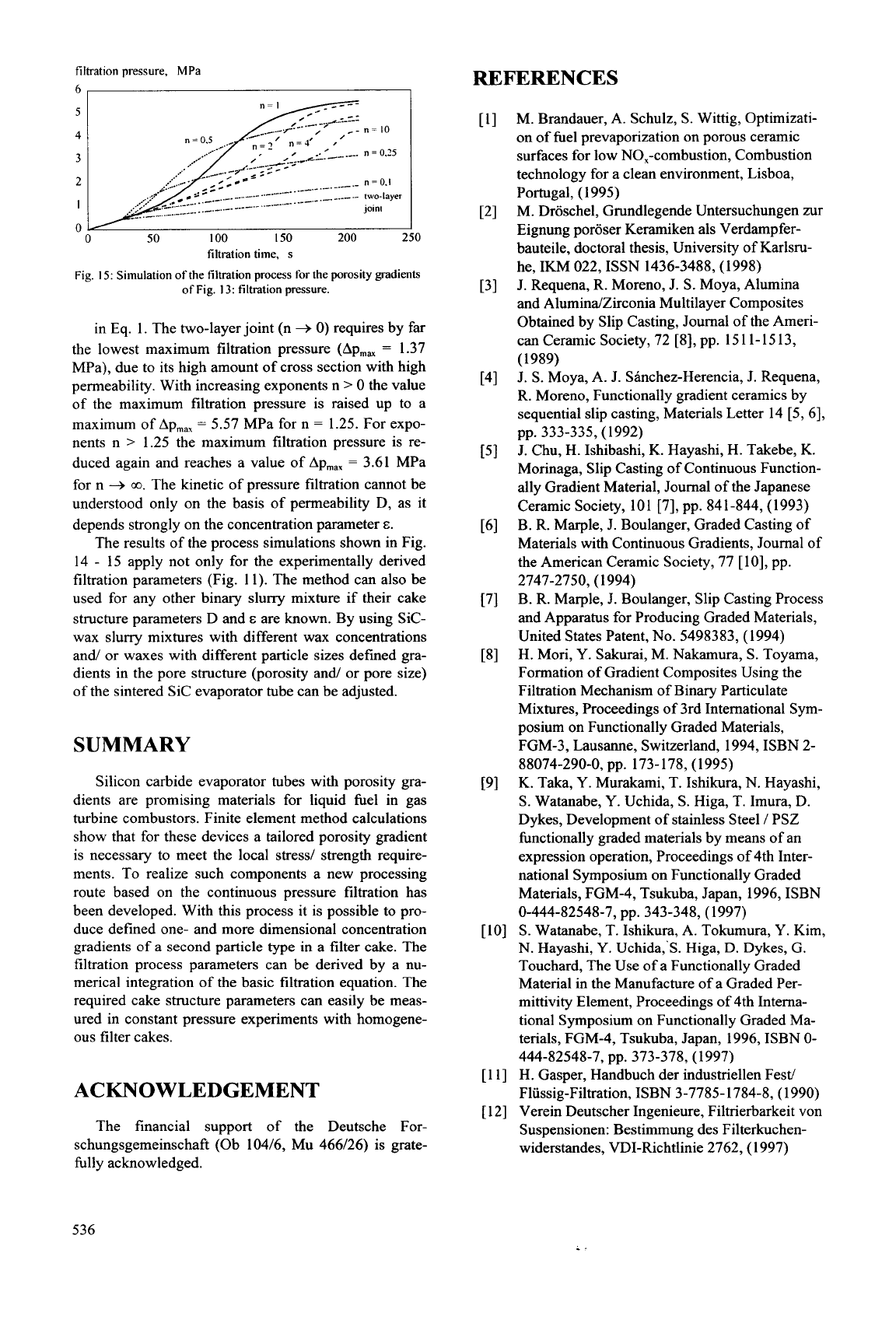
REFERENCES
filtration pressure, MPa
6
5
4
3
2
I
-
.-
joint
two-layer
0
0
50
I00
I50
200
250
filtration time,
s
Fig.
15:
Simulation ofthe filtration process
for
the porosity gradients
of
Fig.
13:
filtration pressure.
in Eq.
1.
The two-layer joint
(n
+
0)
requires by far
the lowest maximum filtration pressure (Apmm
=
1.37
MPa), due to its high amount of cross section with high
permeability. With increasing exponents n
>
0
the value
of the maximum filtration pressure is raised up to a
maximum of Apmax
=
5.57 MPa for
n
=
1.25. For expo-
nents
n
>
1.25 the maximum filtration pressure is re-
duced again and reaches a value of Apmar
=
3.61 MPa
for n
-+
co.
The kinetic of pressure filtration cannot be
understood only on the basis of permeability D, as it
depends strongly
on
the concentration parameter
E.
The results of the process simulations shown in Fig.
14
-
15 apply not only for the experimentally derived
filtration parameters (Fig. 11). The method can also be
used for any other binary slurry mixture if their cake
structure parameters D and
E
are
known.
By using SiC-
wax slurry mixtures with different wax concentrations
and/ or waxes with different particle sizes defined gra-
dients in the pore structure (porosity and or pore size)
of the sintered Sic evaporator tube can be adjusted.
SUMMARY
Silicon carbide evaporator tubes with porosity gra-
dients are promising materials for liquid he1 in gas
turbine combustors. Finite element method calculations
show that for these devices a tailored porosity gradient
is necessary to meet the local stress/ strength require-
ments. To realize such components a new processing
route based
on
the continuous pressure filtration has
been developed. With this process it is possible to pro-
duce defined one- and more dimensional concentration
gradients of
a
second particle type in a filter cake. The
filtration process parameters can be derived by a nu-
merical integration of the basic filtration equation. The
required cake structure parameters can easily be meas-
ured in constant pressure experiments with homogene-
ous
filter cakes.
ACKNOWLEDGEMENT
The financial support of the Deutsche For-
schungsgemeinschaft (Ob 104/6, Mu 466/26) is grate-
hlly acknowledged.
M.
Brandauer, A. Schulz,
S.
Wittig, Optimizati-
on
of fuel prevaporization
on
porous ceramic
surfaces for low NO,-combustion, Combustion
technology for a clean environment, Lisboa,
Portugal, (1995)
M. Droschel, Grundlegende Untersuchungen zur
Eignung poroser Keramiken als Verdampfer-
bauteile, doctoral thesis, University of Karlsru-
he,
IKM
022, ISSN 1436-3488, (1998)
J. Requena, R. Moreno, J.
S.
Moya, Alumina
and AlumindZirconia Multilayer Composites
Obtained by Slip Casting, Journal of the Ameri-
can Ceramic Society, 72 [8], pp. 151 1-1513,
(1989)
J.
S.
Moya, A. J. Sanchez-Herencia,
J.
Requena,
R.
Moreno, Functionally gradient ceramics by
sequential slip casting, Materials Letter 14 [5, 61,
J.
Chu, H. Ishibashi,
K.
Hayashi, H. Takebe, K.
Morinaga, Slip Casting of Continuous Function-
ally Gradient Material, Journal of the Japanese
Ceramic Society,
10
1 [7], pp. 84 1-844,
(
1993)
B.
R.
Marple, J. Boulanger, Graded Casting of
Materials with Continuous Gradients, Journal of
the American Ceramic Society, 77 [lo], pp.
B. R. Marple, J. Boulanger, Slip Casting Process
and Apparatus for Producing Graded Materials,
United States Patent, No. 5498383, (1994)
H. Mori,
Y.
Sakurai, M. Nakamura,
S.
Toyama,
Formation of Gradient Composites Using the
Filtration Mechanism of Binary Particulate
Mixtures, Proceedings of 3rd International Sym-
posium on Functionally Graded Materials,
FGM-3, Lausanne, Switzerland, 1994, ISBN 2-
K.
Taka,
Y.
Murakami, T. Ishikura, N. Hayashi,
S.
Watanabe,
Y.
Uchida,
S.
Higa, T. Imura,
D.
Dykes, Development of stainless Steel
/
PSZ
hnctionally graded materials by means of an
expression operation, Proceedings of 4th Inter-
national Symposium on Functionally Graded
Materials, FGM-4, Tsukuba, Japan, 1996, ISBN
S.
Watanabe, T. Ishikura, A. Tokumura,
Y.
Kim,
N. Hayashi,
Y.
Uchida,’S. Higa, D. Dykes,
G.
Touchard, The Use of a Functionally Graded
Material in the Manufacture of a Graded Per-
mittivity Element, Proceedings of 4th Interna-
tional Symposium
on
Functionally Graded Ma-
terials, FGM-4, Tsukuba, Japan, 1996, ISBN
0-
H.
Gasper, Handbuch der industriellen Fed
Flussig-Filtration, ISBN 3-7785- 1784-8,
(
1990)
Verein Deutscher Ingenieure, Filtrierbarkeit von
Suspensionen: Bestimmung des Filterkuchen-
widerstandes, VDI-Richtlinie 2762, (1 997)
pp. 333-335, (1992)
2747-2750,
(
1994)
88074-290-0, pp. 173- 178,
(
1995)
0-444-82548-7, pp. 343-348, (1997)
444-82548-7, pp. 373-378, (1997)
536
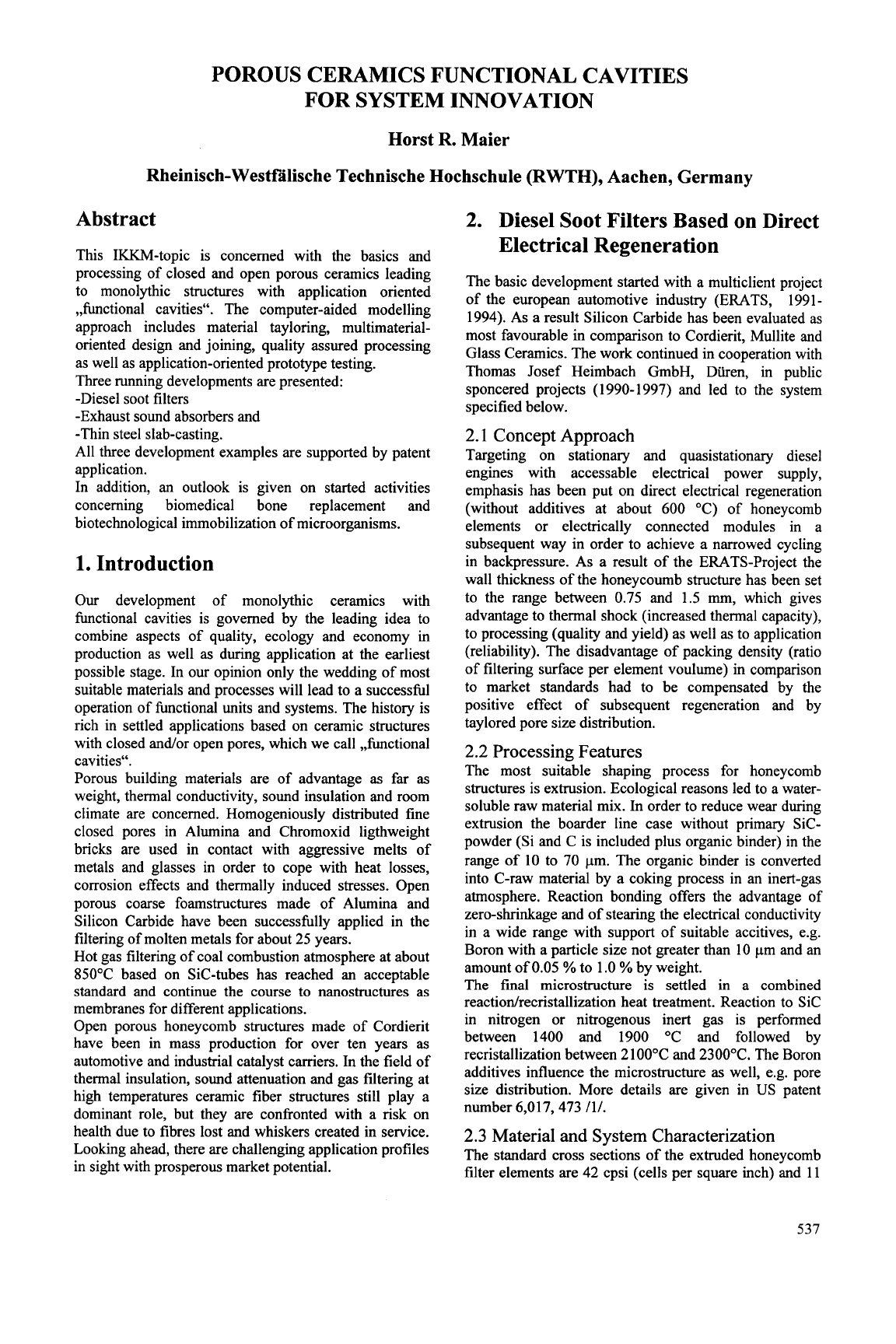
POROUS CERAMICS FUNCTIONAL CAVITIES
FOR SYSTEM INNOVATION
Horst
R.
Maier
Rheinisch-Westfalische Technische Hochschule (RWTH), Aachen, Germany
Abstract
This IKKM-topic is concerned with the basics and
processing of closed and open porous ceramics leading
to monolythic structures with application oriented
,,functional cavities". The computer-aided modelling
approach includes material tayloring, multimaterial-
oriented design and joining, quality assured processing
as
well as application-oriented prototype testing.
Three running developments are presented:
-Diesel soot filters
-Exhaust sound absorbers and
-Thin steel slab-casting.
All three development examples are supported by patent
application.
In addition, an outlook is given on started activities
concerning biomedical bone replacement and
biotechnological immobilization of microorganisms.
1.
Introduction
Our
development of monolythic ceramics with
functional cavities is governed by the leading idea to
combine aspects of quality, ecology and economy in
production as well
as
during application at the earliest
possible stage. In our opinion only the wedding of most
suitable materials and processes will lead to a successful
operation of functional units and systems. The history is
rich in settled applications based on ceramic structures
with closed and/or open pores, which we call ,,functional
cavities".
Porous building materials are of advantage
as
far
as
weight, thermal conductivity, sound insulation and room
climate are concerned. Homogeniously distributed fine
closed pores in Alumina and Chromoxid ligthweight
bricks are used in contact with aggressive melts of
metals and glasses in order to cope with heat losses,
corrosion effects and thermally induced stresses. Open
porous coarse foamstructures made of Alumina and
Silicon Carbide have been successfully applied in the
filtering of molten metals for about 25 years.
Hot gas filtering of coal combustion atmosphere at about
850°C based on SiC-tubes
has
reached an acceptable
standard and continue the course to nanostructures as
membranes for different applications.
Open porous honeycomb structures made
of
Cordierit
have been in mass production for over ten years
as
automotive and industrial catalyst carriers. In the field of
thermal insulation, sound attenuation and gas filtering at
high temperatures ceramic fiber structures still play a
dominant role, but they are confronted with a risk on
health due to fibres lost and whiskers created in service.
Looking ahead, there are challenging application profiles
in sight with prosperous market potential.
2.
Diesel Soot Filters Based on Direct
Electrical Regeneration
The basic development started with a multiclient project
of
the european automotive industry (ERATS, 1991-
1994). As a result Silicon Carbide has been evaluated as
most favourable in comparison to Cordierit, Mullite and
Glass
Ceramics. The work continued in cooperation with
Thomas Josef Heimbach GmbH, Diiren, in public
sponcered projects
(1
990- 1997) and led to the system
specified below.
2.1
Concept Approach
Targeting on stationary and quasistationary diesel
engines with accessable electrical power supply,
emphasis has been put on direct electrical regeneration
(without additives at about
600
"C) of honeycomb
elements or electrically connected modules in a
subsequent way in order to achieve a narrowed cycling
in backpressure. As a result of the ERATS-Project the
wall thickness of the honeycoumb structure has been set
to the range between 0.75 and 1.5 mm, which gives
advantage to thermal shock (increased thermal capacity),
to processing (quality and yield) as well as to application
(reliability). The disadvantage of packing density (ratio
of filtering surface per element voulume) in comparison
to market standards had to be compensated by the
positive effect of subsequent regeneration and by
taylored pore size distribution.
2.2
Processing Features
The most suitable shaping process for honeycomb
structures is extrusion. Ecological reasons led to a water-
soluble raw material mix. In order to reduce wear during
extrusion the boarder line case without primary SiC-
powder (Si and C is included plus organic binder) in the
range of
10
to 70 pm. The organic binder is converted
into C-raw material by a coking process in an inert-gas
atmosphere. Reaction bonding offers the advantage of
zero-shrinkage and of stearing the electrical conductivity
in a wide range with support of suitable accitives, e.g.
Boron with a particle size not greater than 10 pm and an
amount of 0.05
%
to 1
.O
%
by weight.
The final microstructure
is
settled in a combined
reactiodrecristallization
heat treatment. Reaction to Sic
in nitrogen or nitrogenous inert gas is performed
between 1400 and 1900 "C and followed by
recristallization between 2 100°C and 2300°C. The Boron
additives influence the microstructure
as
well, e.g. pore
size distribution. More details are given in
US
patent
number 6,017,473 Ill.
2.3
Material and System Characterization
The standard cross sections of the extruded honeycomb
filter elements
are
42 cpsi (cells per square inch) and 11
537
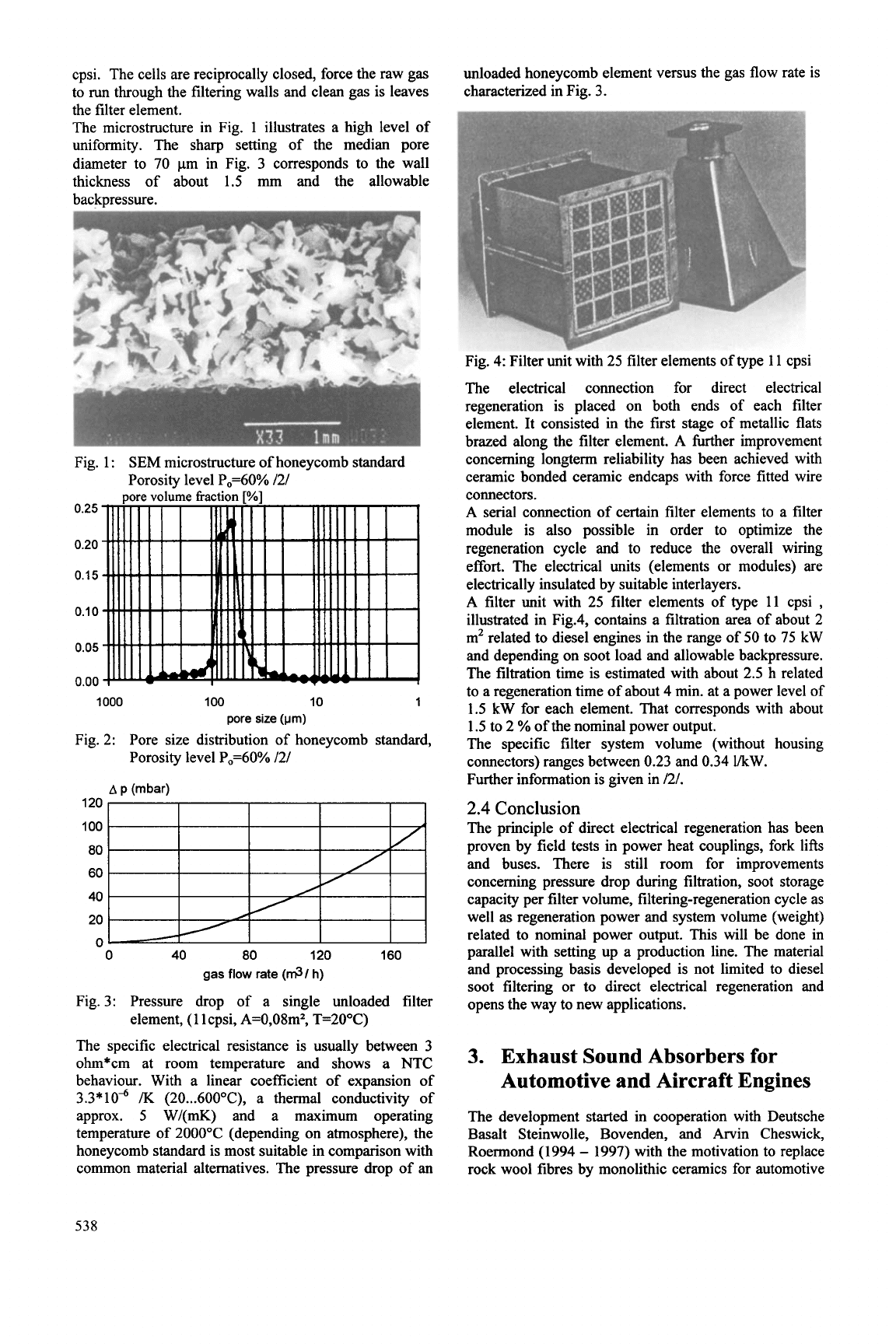
cpsi. The cells are reciprocally closed, force the raw
gas
to
run
through the filtering walls and clean
gas
is leaves
the filter element.
The microstructure in Fig. 1 illustrates a high level of
uniformity. The sharp setting of the median pore
diameter to
70
pm in Fig. 3 corresponds to the wall
thickness of about 1.5 mm and the allowable
backpressure.
Fig. 1
:
SEM microstructure of honeycomb standard
Porosity level P,=60% 121
0.25
0.20
0.15
0.10
0.05
0.00
1000 100 10
1
pore
size
(vm)
Fig. 2: Pore size distribution of honeycomb standard,
Porosity level P,=60% /2/
A
p
(mbar)
120
100
80
60
40
20
0
0
40
80
120
160
gas
flow
rate
(d/
h)
Fig. 3: Pressure drop of a single unloaded filter
element, (1 1 cpsi, A=0,08m2, T=2OoC)
The specific electrical resistance is usually between 3
ohm*cm at room temperature and shows a NTC
behaviour. With a linear coefficient of expansion of
3.3*10"
/K
(20 ...
600"C), a thermal conductivity of
approx. 5 W/(mK) and a maximum operating
temperature
of
2000°C (depending on atmosphere), the
honeycomb standard is most suitable in comparison with
common material alternatives. The pressure drop of an
unloaded honeycomb element versus the gas flow rate is
characterized in Fig. 3.
Fig. 4: Filter unit with 25 filter elements
of
type 1 1 cpsi
The electrical connection for direct electrical
regeneration is placed on both ends of each filter
element. It consisted in the first stage of metallic flats
brazed along the filter element.
A
further improvement
concerning longterm reliability has been achieved with
ceramic bonded ceramic endcaps with force fitted wire
connectors.
A serial connection of certain filter elements to a filter
module is also possible in order to optimize the
regeneration cycle and to reduce the overall wiring
effort. The electrical units (elements or modules) are
electrically insulated by suitable interlayers.
A
filter unit with 25 filter elements of type 11 cpsi
,
illustrated in Fig.4, contains a filtration area of about 2
m2 related to diesel engines in the range of 50 to 75 kW
and depending on soot load and allowable backpressure.
The filtration time is estimated with about 2.5 h related
to a regeneration time of about 4 min. at a power level of
1.5 kW for each element. That corresponds with about
1.5 to 2
%
of the nominal power output.
The specific filter system volume (without housing
connectors) ranges between 0.23 and 0.34 IkW.
Further information is given in 121.
2.4
Conclusion
The principle of direct electrical regeneration has been
proven by field tests in power heat couplings, fork lifts
and buses. There is still room for improvements
Concerning pressure drop during filtration, soot storage
capacity per filter volume, filtering-regeneration cycle as
well
as
regeneration power and system volume (weight)
related to nominal power output. This will be done in
parallel with setting up a production line. The material
and processing
basis
developed is not limited to diesel
soot filtering or to direct electrical regeneration and
opens the way to new applications.
3.
Exhaust Sound Absorbers for
Automotive and Aircraft Engines
The development started in cooperation with Deutsche
Basalt Steinwolle, Bovenden, and Arvin Cheswick,
Roermond (1 994
-
1997) with the motivation to replace
rock wool fibres by monolithic ceramics for automotive
538
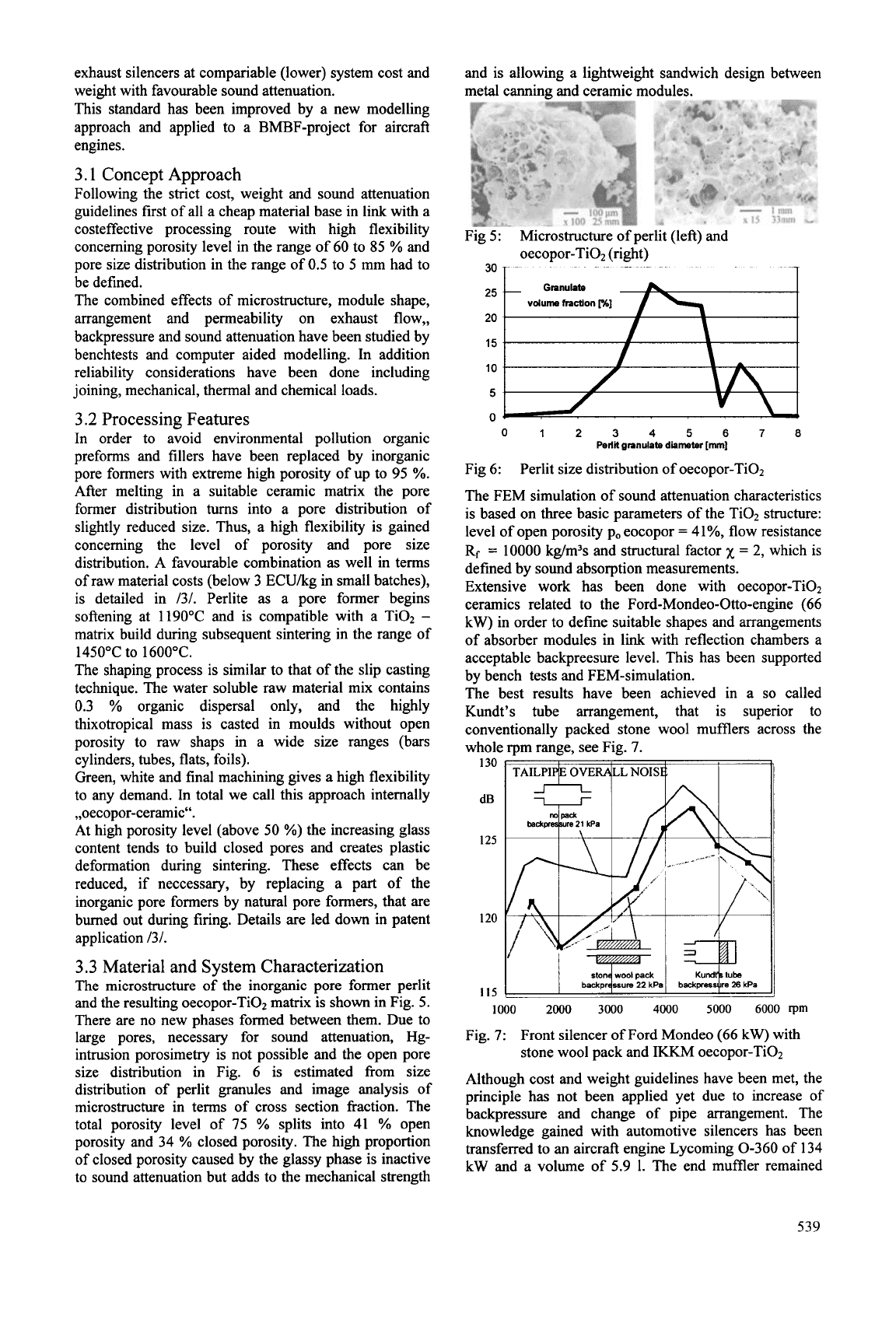
exhaust silencers at compariable (lower) system cost and
weight with favourable sound attenuation.
This standard has been improved by a new modelling
approach and applied to a BMBF-project for aircraft
engines.
3.1
Concept Approach
Following the strict cost, weight and sound attenuation
guidelines first of all a cheap material base in link with a
costeffective processing route with high flexibility
concerning porosity level in the range of
60
to
85
%
and
pore size distribution in the range of
0.5
to
5
mm had to
be defined.
The combined effects of microstructure, module shape,
arrangement and permeability on exhaust flow,,
backpressure and sound attenuation have been studied by
benchtests and computer aided modelling. In addition
reliability considerations have been done including
joining, mechanical, thermal and chemical loads.
3.2
Processing Features
In order to avoid environmental pollution organic
preforms and fillers have been replaced by inorganic
pore formers with extreme high porosity of up to
95
%.
After melting in a suitable ceramic matrix the pore
former distribution
turns
into a pore distribution of
slightly reduced size. Thus, a high flexibility is gained
concerning the level of porosity and pore size
distribution. A favourable combination as well in terms
of raw material costs (below
3
ECUkg in small batches),
is detailed in
131.
Perlite
as
a pore former begins
softening at
1190°C
and is compatible with a Ti02
-
matrix build during subsequent sintering in the range of
1450°C
to
1600°C.
The shaping process is similar to that of the slip casting
technique. The water soluble raw material mix contains
0.3
%
organic dispersal only, and the highly
thixotropical mass is casted in moulds without open
porosity to raw shaps in a wide size ranges (bars
cylinders, tubes, flats, foils).
Green, white and final machining gives a high flexibility
to any demand. In total we call this approach internally
,,oecopor-ceramic".
At high porosity level (above
50
%)
the increasing glass
content tends to build closed pores and creates plastic
deformation during sintering. These effects can be
reduced, if neccessary, by replacing a part of the
inorganic pore formers by natural pore formers, that are
burned out during firing. Details are led down in patent
application
131.
3.3
Material and System Characterization
The microstructure of the inorganic pore former perlit
and the resulting oecopor-Ti02 matrix is shown in Fig.
5.
There are no new phases formed between them. Due to
large pores, necessary for sound attenuation, Hg-
intrusion porosimetry is not possible and the open pore
size distribution in Fig.
6
is estimated from size
distribution of perlit granules and image analysis of
microstructure in terms of cross section fraction. The
total porosity level of
75
%
splits into
41
%
open
porosity and
34
%
closed porosity. The high proportion
of closed porosity caused by the glassy phase is inactive
to sound attenuation but adds to the mechanical strength
25
and is allowing a lightweight sandwich design between
metal canning and ceramic modules.
.. .
-
Granulate
--
vdume
fraction
pi]
/A\
dB
125
120
ston
wool
pack
backpr
%urn
22
kPa
115
1000
2000
3000
4000
5000
6000
rpm
Fig.
7:
Front silencer
of
Ford Mondeo
(66
kW)
with
stone wool pack and IKKM oecopor-Ti02
Although cost and weight guidelines have been met, the
principle has not been applied yet due to increase of
backpressure and change of pipe arrangement. The
knowledge gained with automotive silencers has been
transferred to an aircraft engine Lycoming
0-360
of
134
kW and a volume of
5.9
1.
The end muffler remained
539
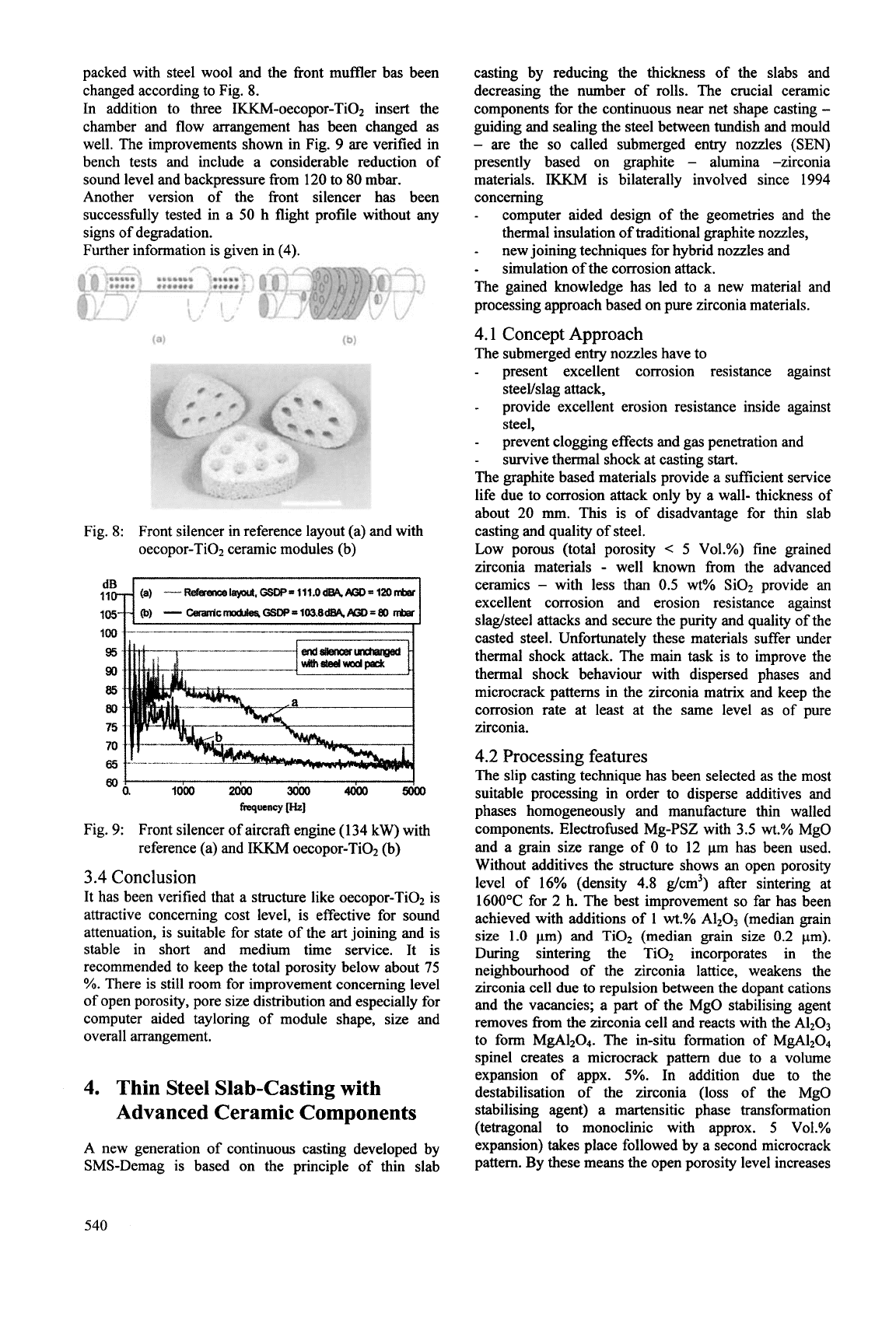
packed with steel wool and the front muffler bas been
changed according to Fig.
8.
In addition to three IKKh4-oecopor-Ti02
insert the
chamber and flow arrangement has been changed
as
well. The improvements shown in Fig. 9 are verified in
bench tests and include a considerable reduction of
sound level and backpressure from
120
to
80
mbar.
Another version of the front silencer has been
successfully tested in a
50
h flight profile without any
signs of degradation.
Further information is given in (4).
Fig. 8: Front silencer in reference layout (a) and with
oecopor-Ti02 ceramic modules (b)
105
100
95
90
85
80
75
Fig. 9: Front silencer of aircraft engine (134
kw)
with
reference (a) and
IKKM
oecopor-Ti02 (b)
3.4
Conclusion
It
has been verified that a structure like oecopor-Ti02 is
attractive Concerning cost level, is effective for sound
attenuation, is suitable for state of the art joining and is
stable in short and medium time service. It is
recommended to keep the total porosity below about
75
'3'0.
There is still room for improvement concerning level
of open porosity, pore size distribution and especially for
computer aided tayloring of module shape, size and
overall arrangement.
4.
Thin Steel Slab-Casting with
Advanced Ceramic Components
A new generation of continuous casting developed by
SMS-Demag is based on the principle of thin slab
casting by reducing the thickness
of
the slabs and
decreasing the number of rolls. The crucial ceramic
components for the continuous near net shape casting
-
guiding and sealing the steel between tundish and mould
-
are the
so
called submerged entry nozzles
(SEN)
presently based on graphite
-
alumina -zirconia
materials. IKKM is bilaterally involved since 1994
concerning
-
computer aided design of the geometries and the
thermal insulation of traditional graphite nozzles,
new joining techniques for hybrid nozzles and
simulation of the corrosion attack.
-
-
The gained knowledge has led to a new material and
processing approach based on pure zirconia materials.
4.1
Concept Approach
The submerged entry nozzles have to
-
present excellent corrosion resistance against
steeuslag attack,
-
provide excellent erosion resistance inside against
steel,
-
prevent clogging effects and gas penetration and
-
survive thermal shock at casting
start.
The graphite based materials provide a sufficient service
life due to corrosion attack only by a wall- thickness of
about
20
mm. This is of disadvantage for thin slab
casting and quality
of
steel.
Low porous (total porosity
<
5
Vol.%) fine grained
zirconia materials
-
well known from the advanced
ceramics
-
with less than
0.5
wt%
Si02 provide an
excellent corrosion and erosion resistance against
slag/steel attacks and secure the purity and quality of the
casted steel. Unfortunately these materials suffer under
thermal shock attack. The main task
is
to improve the
thermal shock behaviour with dispersed phases and
microcrack patterns in the zirconia matrix and keep the
corrosion rate at least at the same level
as
of pure
zirconia.
4.2
Processing features
The slip casting technique has been selected
as
the most
suitable processing in order to disperse additives and
phases homogeneously and manufacture thin walled
components. Electrofbsed Mg-PSZ with
3.5
wt.%
MgO
and a grain size range of
0
to
12
pm has been used.
Without additives the structure shows an open porosity
level of 16% (density 4.8 g/cm3) after sintering at
1600°C for
2
h. The best improvement
so
far has been
achieved with additions of
1
wt.%
A1203 (median grain
size
1.0
pm) and TiOz (median grain size
0.2
pm).
During sintering the Ti02 incorporates in the
neighbourhood of the zirconia lattice, weakens the
zirconia cell due to repulsion between the dopant cations
and the vacancies; a part of the MgO stabilising agent
removes from the zirconia cell and reacts with the A1203
to form MgA1204. The in-situ formation
of
MgAlz04
spinel creates a microcrack pattern due to a volume
expansion of appx.
5%.
In addition due to the
destabilisation of the zirconia (loss of the MgO
stabilising agent) a martensitic phase transformation
(tetragonal to monoclinic with approx.
5
Vol.%
expansion) takes place followed by a second microcrack
pattern. By these means the open porosity level increases
540
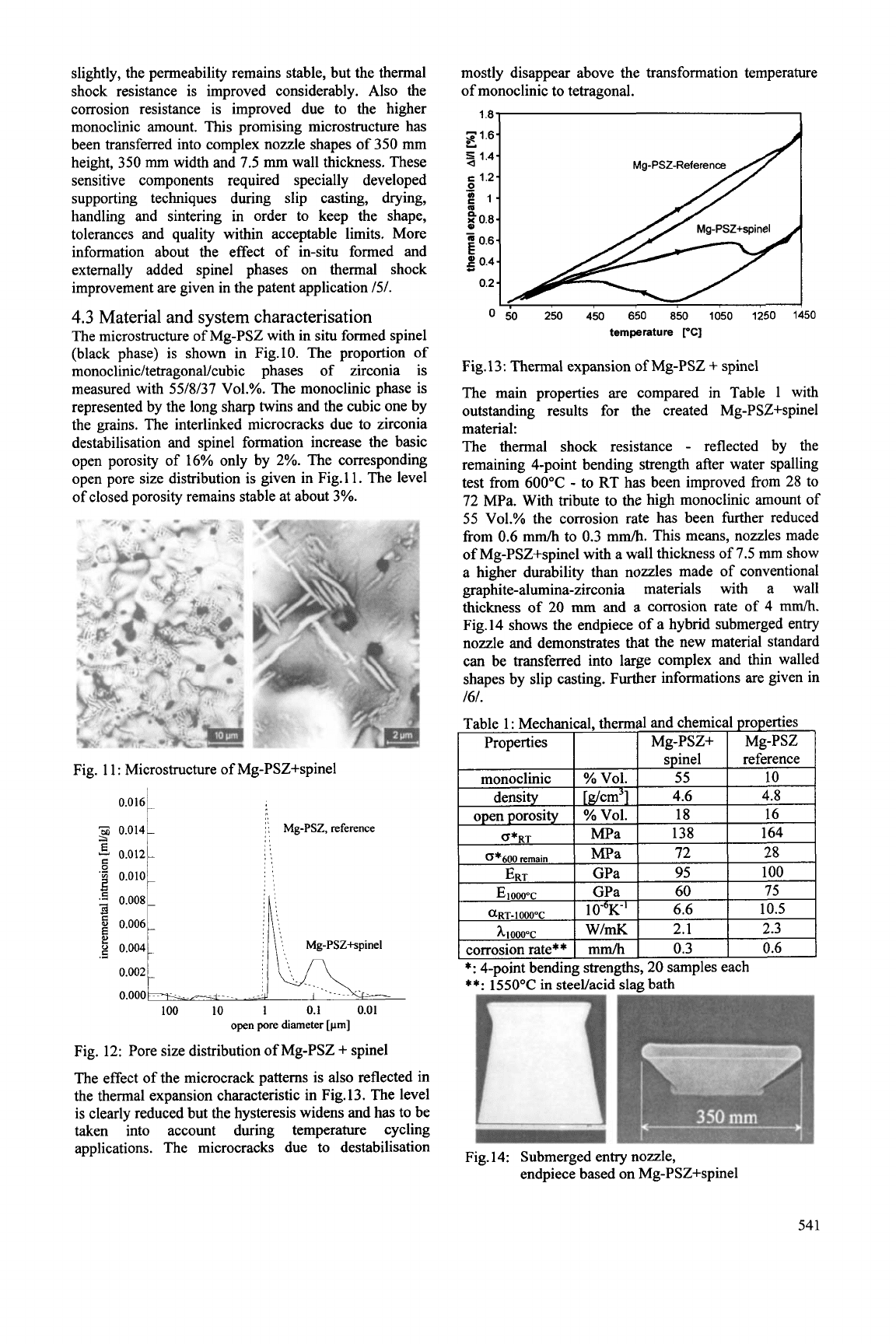
slightly, the permeability remains stable, but the thermal
shock resistance is improved considerably.
Also
the
corrosion resistance is improved due to the higher
monoclinic amount. This promising microstructure has
been transferred into complex nozzle shapes of 350 mm
height, 350 mm width and 7.5 mm wall thickness. These
sensitive components required specially developed
supporting techniques during slip casting, drying,
handling and sintering in order to keep the shape,
tolerances and quality within acceptable limits. More
information about the effect of in-situ formed and
externally added spinel phases on thermal shock
improvement are given in the patent application 151.
4.3
Material and system characterisation
The microstructure
of
Mg-PSZ with in situ formed spinel
(black phase) is shown in Fig.10. The proportion
of
monoclinic/tetragonaVcubic
phases
of
zirconia is
measured with 55/8/37 Vol.%. The monoclinic phase is
represented by the long sharp twins and the cubic one by
the grains. The interlinked microcracks due to zirconia
destabilisation and spinel formation increase the basic
open porosity of
16%
only by 2%. The corresponding
open pore size distribution is given in Fig. 1 1. The level
of closed porosity remains stable at about 3%.
“1.6-
5
1.4-
c
1.2-
E
-
e
1-
8
0.8.
i
06.
-
0.4-
0.2
-
Fig. 1 1
:
Microstructure of Mg-PSZ+spinel
:\
Mg-PSZ,
reference
0.016
“M
0.014
L
mostly disappear above the transformation temperature
of monoclinic to tetragonal.
4Q
I.”
,
I
0
$0
250
450
650
850
1050
1250
1450
temperature
[‘C]
Fig. 13
:
Thermal expansion of Mg-PSZ
+
spinel
The main properties are compared in Table 1 with
outstanding results for the created Mg-PSZ+spinel
material:
The thermal shock resistance
-
reflected by the
remaining 4-point bending strength after water spalling
test from
600°C
-
to RT has been improved from 28 to
72 MPa. With tribute to the high monoclinic amount of
55 Vol.% the corrosion rate has been further reduced
from
0.6
mmh to 0.3 mmh. This means, nozzles made
of Mg-PSZ+spinel with a wall thickness of 7.5 mm show
a higher durability than nozzles made of conventional
graphite-alumina-zirconia
materials with a wall
thickness of
20
mm and
a
corrosion rate of 4
mm/h.
Fig.14 shows the endpiece
of
a hybrid submerged entry
nozzle and demonstrates that the new material standard
can be transferred into large complex and thin walled
shapes by slip casting. Further informations are given in
161.
Table 1
:
Mechanical, thermal and chemical properties
I
Properties
I
I
Mg-PSZ+
I
Mg-PSZ
1
i
E
-
0.012
8
‘3
0.010
**:
i55OoC
in stedacid-slag bath
100
10
1
0.1 0.01
open pore diameter
[pm]
Fig. 12: Pore size distribution of Mg-PSZ
+
spinel
The effect of the microcrack patterns is also reflected in
the thermal expansion characteristic in Fig.13. The level
is clearly reduced but the hysteresis widens and has to be
taken into account during temperature cycling
applications. The microcracks due to destabilisation
Fig. 14: Submerged entry nozzle,
endpiece based on Mg-PSZ+spinel
541
